


Table of Contents
![]()
Feature Article
Finding Pictures
Michael Lesk, Director, Information and Intelligent Systems,
National Science Foundation
lesk@lesk.com
Introduction
Why is it that we have general routines for indexing text on
any kind of subject, but graphics routines historically are
specialized to particular kinds of images?
(1) Typically pictures
have been indexed by writing a little bit of text about each
picture, and then handling the text in conventional ways. Can we
replace that?
Two main threads of mechanized image analysis are being researched. One approach has a model of what is in the picture, and looks for it specifically. The other tries to model the picture by looking at general properties of the picture, such as the colors used, the large shapes in the picture, or the textures. It is also possible to supplement image analysis with other ways of finding pictures. Any text related to a picture, such as a caption, can be used to help search for it; and people are very good at browsing through large numbers of pictures quickly, causing systems to develop interfaces that display lots of thumbnails for quick review.
How to Index Pictures
Mary Larsgaard quoted IBM in 1994 saying "There is still no
substitute for trained librarians tagging the photos with
keywords'' (2).
National Geographic, for example, employs some twenty
indexers to catalog the hundreds of thousands of photographs they
add to their files each year. A large thesaurus is used, and the
cataloging staff works carefully enough that if an editor wishes
to find a picture of an oil tanker with herons flying over it,
that can be done. As Larsgaard says, this process still cannot be
automated. There are many projects that are studying the indexing
of images by automatic content analysis, but they can not achieve
the level of detail and accuracy needed to replace a truly
professional manual indexing system.
The most successful form of image analysis is the detailed analysis of an image for a particular content item. The analysis of aerial photography for particular buildings or tanks, or the search of bubble chamber photographs for particle tracks, or the examination of pictures of devices (e.g., chips) looking for defects, are examples that date back in some case to the 1960s. The most widely known use of this kind of software is OCR (optical character recognition).
Even for OCR, however, there are two strategies possible. One is exact match, given a template or many templates of the items to be sought. The other is to do feature extraction, and then try to apply rules that deduce content from feature occurrences (e.g., "a letter with an downstroke below the baseline but no horizontal gap in it must be a j"). Although the methods used by OCR programs are commercial secrets, rumor is that over the years exact-match has been gaining over feature extraction as a reliable way of recognizing text (note that few programs today are trainable).
Current Research
Commercial programs for image cataloging are largely oriented
towards maintenance of image collections, and thus often just
maintain a text file of picture descriptions, perhaps with
thumbnails, as in the late lamented Kodak Shoebox, its replacement
Canto
Cumulus, or
Extensis
Portfolio, previously known as Aldus Fetch. Various cataloging
systems do this on a larger scale, or on a more professional
level, targeting users who are librarians or archivists and are
familiar with MARC records or similar structures.
Some commercial systems do support image similarity or image query, such as the Virage Engine (3), Excalibur Visual RetrievalWare, or the Illustra DataBlade, now marketed by Informix. In general, the details of these systems are proprietary.
The best known commercial system for image searching, and the one which really revolutionized the idea of image searching, was the IBM QBIC (query by image content) system (4). QBIC can use colors, textures, and shapes to search for images. An example is a trademark browser that searches for shapes in a file of registered trademark images. The shape matching is rough; a search for a teardrop, for example, found an ice cream cone and a figure 8.
The Center for Intelligent Information Retrieval at the University of Massachusetts also does color and shape searching. An interesting feature of the work (done with Chandra Ravela) is that mathematical methods are used to categorize different shapes by their inertial moments. This has hopes of being more general than many other systems.
Other projects that support similar categorization methods are Photobook at MIT and the UC Berkeley Digital Library Project. Both combine many aspects of image searching. The MIT system lets you train the search engine so that it can learn what image features you consider important (e.g., whether color histograms or textures are more significant in your searching).
Here, for example, is an illustration of some images found by the Berkeley routine that has a body plan for horses and searches for it:
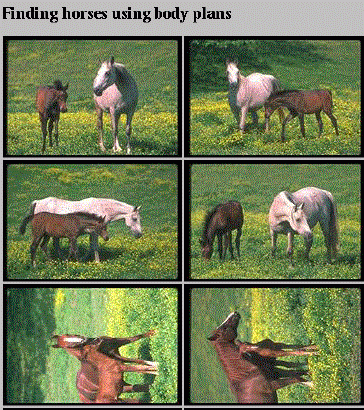
Another such system is the routine developed at Carnegie Mellon University (CMU) that looks for faces in broadcast video images (5). Below is an example of its work.
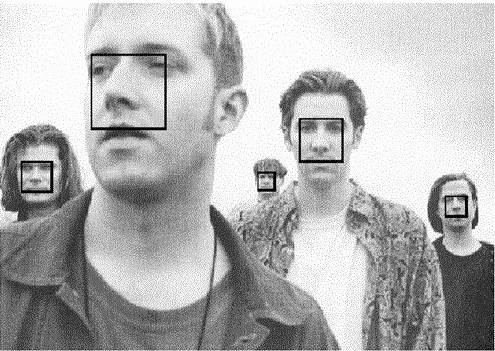
CMU is extending this research both to match faces with a library of faces, and to find the names of the people depicted (by looking at the soundtrack or captioning of the video). At the moment the process is limited. The face must be pretty much full-screen, front-facing, and the name is often a mistake, but in principle project staff can foresee how to search a video broadcast for a particular person.
Some particularly interesting projects are the ones that search compressed images. One would hope that compression would remove the irrelevant parts of images and make searching easier, but it is still unusual to find systems searching the compressed format. Columbia University has its WebSEEk program, for example, that looks at color histograms and also uses high-speed browsing. It has indexed over 650,000 images from the Web.
Another example of a system that does compressed domain searching is that of James Griffioen and others at the University of Kentucky (6). They compute eigenvectors for the compressed image, use that as the basis for searching, and can prove that the distance between vectors in uncompressed image space is related to that in the compressed space.
Conclusions
We have some very rough research tools for finding pictures at
a gross level; animals, people, sunsets, lakes, and the like. We
are still not able to do the more intellectual kinds of searches
(e.g., "find cartoons about digital libraries"). The vast range of
images to be searched means that we still must rely on catalogers
and upon browsing; but there is hope that in the future we can
automate more and more of the process of cataloging, and
eventually make image collections more widely available.
(1) Lesk, Michael E. "Graphical Information Resources: Maps and Beyond." Proceedings of the 8th International SIGIR Conference. (June 1985), pp. 2-8. (Return to Text)
(2) Larsgaard, Mary Lynette. "Content-Based Searching of Large Image Databases." http://www.uky.edu/~kiernan/DL/larsgaard.html. (Return to Text)
(3) Gupta, Amarnath. "Visual Information Retrieval: A Virage Perspective." http://www.virage.com/wpaper (Return to Text)
(4) Flickner, et al. "Query by image and video content: the QBIC system." IEEE Computer. vol. 28, no. 9 (September 1995), pp. 23-32. (Return to Text)
(5) Gong, Yihong. "Recognition and Retrieval of News Video -Vision Research for Informedia Project." (January 1998), http://www.ius.cs.cmu.edu/IUS/inf09/ygong/WWW/DLI98/index.htm (Return to Text)
(6) Griffioen, James; Seales, Brent; and Yavatkar, Raj. "Content-based Multimedia Data Management and Efficient Remote Access." (October 1995), http://www.uky.edu/~kiernan/DL/brent.html. (Return to Text)
Technical Feature
What is an MTF ... and Why Should You Care?
Don Williams, Image Scientist, Eastman Kodak Company
williams@image.kodak.com
Introduction
Modulation Transfer Function (MTF) is the scientific means of evaluating the fundamental spatial resolution performance of an imaging system, or components of that system. The purpose of this article is to introduce the MTF concept and its use, and to show why it is a superior way of specifying spatial resolution compared to other methods such as dots-per-inch (dpi) or visual bar target readings.
What is Resolution and How Does it Relate to MTF?
Resolution is a measure of how well spatial details are preserved. The measuring of two items are required to define it: (1) spatial detail and (2) preservation. It is these fundamental metrics of detail and preservation that define MTF.
Detail and preservation metrics are not single measurements, but rather a continuum of measurements, which is why a functional curve quantifying them, i.e., the MTF, can be plotted. A range of spatial details is characterized by how well each and every one of those details is preserved, some better than others. An entire set of point pairs are then plotted - a measure of spatial detail or "frequency" on the x-axis and "extent of preservation" of that detail on the y-axis - to form the MTF as illustrated in Figure 1.
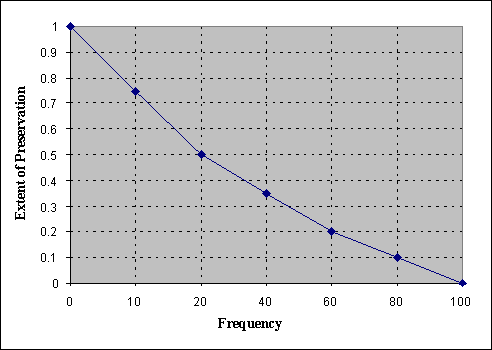
How is MTF Measured?
As stated above, two items are required for defining the MTF: (1) a measure of spatial detail, called frequency, and (2) a fundamental measure for determining how that detail is preserved, called modulation transfer. These will be addressed in that order.
Frequency - Spatial detail can be measured by the spatial frequency content of a given feature. A good example of this is the frequency of the line features in any 5 line bar target group. Each of the labeled line groups in a target indicates the spatial frequency for that group. For instance, the group labeled 2.0 has a frequency of 2.0 line pairs per millimeter (2.0 lp/mm). A line pair (dark-line/white-space combination) is more universally referred to as one cycle. For this example then, one cycle (line pair) spans 1/2.0 = 0.50 mm. The higher the frequency, the greater the detail, the greater the number of cycles per unit distance, and the more closely spaced the lines become.
In scientific lexicon, the lines in the bar target cited above are called square-wave signals. This term derives from the square corners of their light intensity profile, as shown in the left hand side of Figure 2 below. Though square wave signals are easy to manufacture into targets and can be used to measure MTF when properly treated, alone, they are not considered to be basic image building blocks. As such it is technically incorrect to use them as reference signals in determining MTFs. Instead, sine-waves are used. An example of a sine-wave signal compared with a square-wave of the same frequency is also shown in Figure 2. Below each image is a cross-section plot of their light intensity profiles.
|
|
|
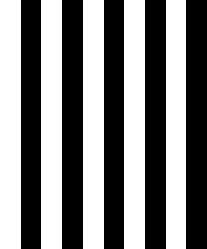 |
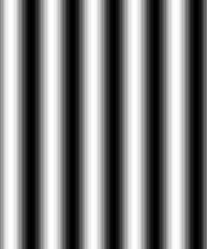 |
|
| |
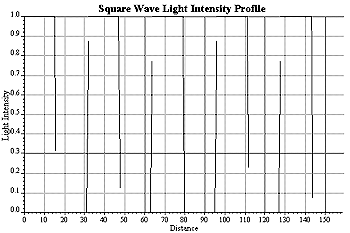 |
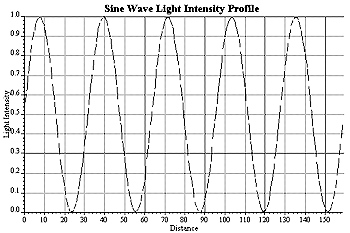 |
|
| |
Sine-wave frequencies, usually in units of cycles/mm, are used as the metric for specifying detail in an MTF plot. These frequencies are always plotted as the independent variable on the x-axis. To complete the MTF metric, a measure of how well each sine-wave frequency is preserved after being imaged, i.e., transferred through an imaging device, is required. This measure, called modulation transfer, is plotted along the y-axis for each available frequency and completes the specification of MTF.
Modulation Transfer - The modulation for any signal is defined with two variables of that signal, the maximum light intensity value, Imax, and minimum light intensity value, Imin. Modulation is formulated as the quotient of their differences to their sums, as follows:
|
Modulation = |
(Imax - Imin) |
|
(Imax + Imin) |
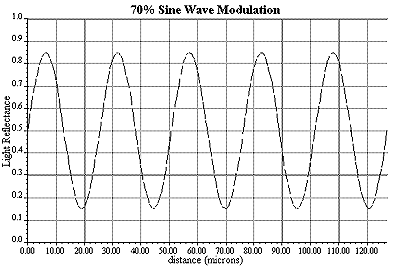 |
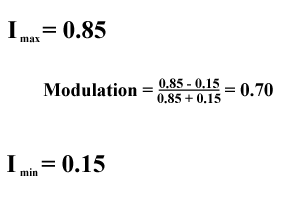 |
The goal in determining MTF is to measure how well the input modulation is preserved after being imaged or in some way acted upon. This modulation transfer is quantified by comparing the modulations of the output sine-waves after being imaged to the target's input sine-wave modulations before being imaged. This comparison is a simple ratio of output modulation to input modulation. It is formulated as:
|
Modulation Transfer = |
(Output Modulation) |
= |
(Mo) |
|
(Input Modulation) |
(Mi) |
The modulation transfer calculation is now complete. For a number of known frequencies, f, with known input modulations, Mi, an output modulation, Mo, can be determined after imaging. The ratio of Mo/Mi is then plotted for each frequency. The resulting curve is the Modulation Transfer Function, or MTF. It is also sometimes called the Signal Frequency Response, or SFR.
An Example
Suppose one wished to determine the MTF of a desktop document scanner. A straightforward way of doing this is through the use of a sine-wave target. A good one will have a range of sine-wave frequencies along with solid gray patch areas used for calibration. The target will come with supporting literature regarding the frequencies of each sine-wave, their modulation, and the reflectances of the gray patches
One would place the target on the platen, ensure it is properly aligned, choose a scanning resolution, and perform an 8-bit/channel (256 gray levels) scan. One now has a digital image of that target with potential count values ranging from 0 through 255 for each color channel. The calibration patches would then be used to ensure that the data was linear with respect to count value. For simplicity, the green channel alone will be analyzed. With a digital image analysis program, such as Adobe Photoshop®, one would determine the average minimum and average maximum count value associated with the darkest and lightest areas of each sine-wave frequency. These minimum and maximum count values are used to determine the output modulation, Mo, for each of the available frequencies. The modulation transfer would then be calculated. In tabular form these calculations appear as follows.
|
(cycles/mm) |
Modulation |
value (out ) |
value (out) |
Modulation |
Transfer |
|
|
|
|
|
|
|
|
|
|
|
|
|
|
|
|
|
|
|
|
|
|
|
|
|
|
|
|
|
|
|
|
|
|
|
|
|
|
|
|
|
|
|
|
|
|
|
|
|
|
|
|
|
|
|
|
|
|
|
|
|
|
|
|
|
|
|
|
|
|
A plot of Modulation Transfer vs. Frequency yields the MTF for the scanner with the selected settings (i.e., dpi, sharpening, bit depth, etc.) as illustrated in Figure 4 below.
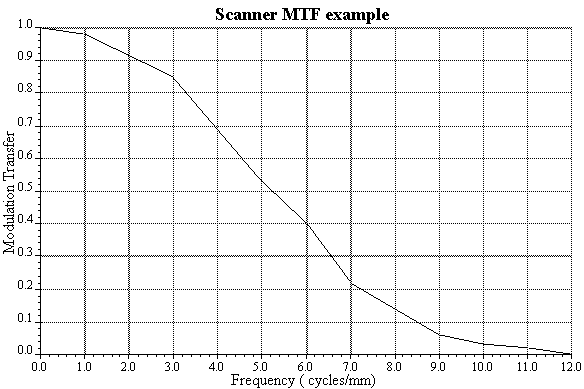
How is the MTF Curve Interpreted?
The MTF shape of Figure 4 is typical for a well-behaved optical imaging device such as a document scanner. It begins with near unity modulation at zero-frequency and gradually becomes lower towards higher frequencies, until at some point the modulation becomes zero and remains so for all higher frequencies.
A simple way to interpret the modulation transfer is by thinking of it as a measure of how well the scanner preserves the average contrast of each input sine-wave frequency. A modulation transfer of 1 indicates that the average contrast for a given sine-wave frequency is perfectly maintained, while zero modulation transfer shows that it was completely lost, or not "seen" in the imaging process. Values between 0-1 indicate varying degrees of contrast preservation. Though there are exceptions, generally, the higher the modulation transfer, the better the preservation of detail by the imaging system.
Perhaps the best way to become grounded in interpreting MTF is through the use of example images captured using scanners with various MTFs. Figure 5 shows such an example for a section of an RIT Alphanumeric Resolution Test Object. (1)
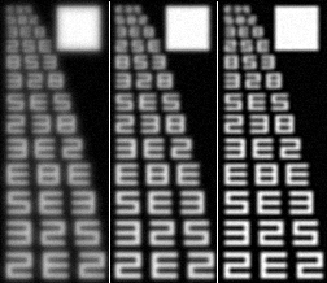
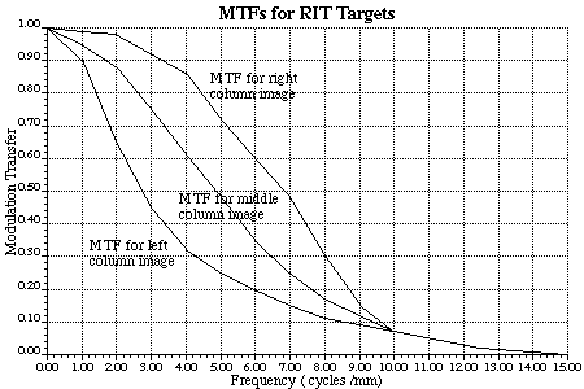
The MTFs for each of the optical systems through which the target was imaged are labeled in the MTF plots below the image. Though the majority of the character sets are readable, their degree of legibility is quite different. The spatial image quality of the image on the right is superior to its two neighbors, and the middle one is superior to its left neighbor. This difference is reflected in the shape of the MTF. Figure 5 also illustrates why limiting resolution metrics derived from visual evaluations of classical targets of bars, characters, or other square wave-like features often fall short as spatial resolution tools.
Why is MTF Better Than Other Resolution Measures?
Limiting Resolution - If one were to use a limiting resolution technique, such as visual bar target readings on the examples of Figure 5, each image would be rated the same since the smallest or limiting character group that can be just visually detected in each would be the "25E" group (near the bottom of the white square). These visual judgments of limiting resolution are considered threshold metrics because they rely on judgments of the threshold at which spatial resolution breaks down, and not the way it performs in getting to that threshhold. Though useful in statistical analyses, one-bit imagery, and noise-limited imaging, limiting resolution is not considered fundamental for resolution measurement. The three imaging systems illustrated in Figure 5 would have been judged equivalent with a limiting resolution metric. It is clear that they are not the same in terms of character image quality.
Dots Per Inch - For completeness, a few words on why specifying resolution of digital scanners in terms of dpi is misleading. The addressable resolution, specified in dots-per-inch (dpi), is marginally useful for evaluating true scanner resolution, but is only an indication of the sampling interval between pixels. It is not an indication of what size detail the scanner can ultimately see, or its MTF behavior, as much as it is of how finely the center of a pixel can be located.
For instance, it is reasonable to assume that a 400 dpi scanner will precisely sample a scanned document every 1/400". It is not reasonable to assume, however, that it will actually "see" details this small. It may be able to detect details only as fine as a good 300 dpi scanner. In fact, for most desktop document scanners, the disparity between the sampling interval and actual detail detection becomes highly probable for claimed addressable resolutions beyond 1000 dpi.
Relying on dpi is like trying to compare the passing of either a needle (small cross section) or a large nail (large cross section) through common door screening. Although both can be accurately located at any screen opening, because of its small size, only the needle will make it through. The same can be said of a digital document scanner. The sampling interval (screen spacing) does not determine how large or small an area that the scanner can see, but only how frequently it sees it.
Imaging System Analysis - Perhaps the single biggest benefit of using MTFs is for their utility in evaluating systems of connected imaging components. Besides the example of a scanner used in this paper, other system components, such as image processing, human vision, and information display, can also be cast in terms of MTF performance. Because MTF measurements are fundamental, the MTFs of these individual components can be cascaded to predict the way that a system of components will perform as a unit in terms of spatial resolution.
Conclusion
At a recent digitizing conference, one of the more prestigious speakers proclaimed, "Resolution is dead!" The message was that resolution was well understood with the real future challenge being consistent color reproduction. While the latter is no doubt a big hurdle, the trivializing of measuring spatial resolution as if it were a fashion trend is unfortunate, especially considering that most practitioners' understanding of resolution stops at either limiting resolution or addressable resolution. The truly basic way of quantifying actual spatial resolution is through MTF analysis. It is one of the most important benchmarks for imaging performance in the scientific community because it is fundamental.
Software tools for easily evaluating MTF of typical capture devices are on the verge of finding their way into the user community, and are currently being tested via efforts of standards committees. The Photographic and Imaging Manufacturers Association, Technical Committee on Electronic Still Imaging (PIMA/IT10) maintains an excellent Web site on standards development in this area. The committee just recently announced the availability of a camera resolution test chart and measurement software. As these tools are more publicly available, they will become basic references for true evaluation of spatial resolution performance.
Footnote:
(1) RIT Alphanumeric Resolution Test Object is available from the Rochester Institute of Technology (716-475-2739).
Highlighted Web Sites
National
Archives and Records Administration (NARA), Monitor Adjustment
Target
NARA's Archival Information Locator (NAIL) is a pilot database
containing information about a wide variety of NARA holdings
across the country. In addition to the holdings information, it
provides direct access to more than 20,000 digital images. To
ensure the correct retrieval of these images, NAIL provides an
online target for use in adjusting computer monitors. This target
has been designed to allow computer users to set the contrast and
brightness of their monitor so that graphic images, such as scans
of photographs, textual documents, or maps, look their best.
Kodak
Reference Image
The primary purpose of this reference image is to help
optimize your monitor and method of Photo CD image acquisition for
optimal display of Photo CD images. The Kodak Reference Image was
created through purely digital means, and the patches represent
ideal neutral colors. This target can also be used to evaluate and
control color calibration of computer monitors.
For Macintosh:
ftp://ftp.kodak.com/pub/photo-cd/general/referenceImage.sea.hqx
For Windows:
ftp://ftp.kodak.com/pub/photo-cd/general/referenceImage.exe
The following file contains information on how to use the
reference image:
ftp://ftp.kodak.com/pub/photo-cd/general/pcd102.txt.gz
Calendar of Events
Digital Libraries in the New Millennium: Building on Our
Past
March 11-13, 1998
The Tompkins-McCaw Library, in collaboration with the Virginia
Council of Health Sciences Librarians (VaCOHSL) and the IBM
Renaissance Consortium, is hosting a special conference to
commemorate its history and to explore the electronic library of
the future. The conference, "Digital Libraries in the New
Millennium: Building on Our Past," will be held March 11-13, 1998
on the Medical College of Virginia Commonwealth University,
Richmond, Virginia. For further information contact: John D.
Jones, Jr., jdjones@vcu.edu,
or call 804-828-1881.
Digital Libraries
Asia '98 Conference & Exhibition
March 17-20, 1998
The Digital Era: Implications, Challenges & Issues Asia '98
Conference will be held in Singapore at the Westin Stamford. This
conference aims to provide participants with the means to face the
challenges of today's knowledge economy by focusing on the newer
ways of managing and obtaining information as well as keeping
abreast of the new and emerging technologies in information
services. The 1998 Conference will focus on a showcase of
successful applications and developments that have taken place
since 1995. For more information, contact : Lena Kua, Programme
Manager, Marketing and Promotion, Digital Library Cluster,
National Computer Board, Singapore 118253 Tel: 65-7720401 Fax:
65-7770120 Email:
lenakua@ncb.gov.sg
Museums and the
Web
April 21-15, 1998
A conference focusing on Museums and the Web will be held in April
in Toronto, Canada. The event is organized by Archives &
Museum Informatics and sponsored by the Canadian Heritage
Information Network. There will be more than 60 papers by over 100
authors from 16 countries, who will explore issues and
controversies, highlight museum applications, and take an in-depth
look at particular uses of the Web at exceptional museum sites.
Advances
in Digital Libraries, 1998
April 22-24, 1998
The goal of this conference is to share and disseminate
information about important current issues concerning digital
library research and technology. The conference will be held in
Santa Barbara, California and is sponsored by Alexandria Digital
Library, CESDIS, IEEE Computer Society, Library of Congress, NASA
Goddard Space Flight Center, and the National Library of Medicine.
There will be research papers, invited talks, workshops, and
panels involving leading experts, as well as demonstrations of
innovative and prototype technologies.
RLG's
Managing Digital Imaging Projects Workshop
May 13-15, 1998 & May 18-20, 1998
RLG is pleased to offer two sessions of its 2.5 day
workshop designed to assist librarians, archivists, curators, and
preservation administrators in managing digital imaging projects,
to be held May 1998 at the University of Leeds, UK. Registration
is now open for these two sessions. For further information
contact: Robin Dale,
bl.rld@rlg.org.
Digital Reality:
Managing Electronic Resources
June 1-2, 1998
This two-day conference, in Marlborough, Massachusetts, will
re-examine traditional library structures and explore alternatives
for integrating and managing electronic resources. The conference
is sponsored by NELINET's advisory committees for Interlibrary
Loan, Reference, Union Listing, Quality Control & Cataloging,
and Preservation.
Sixth
DELOS Workshop: Preservation of Digital Information
June 17- 19, 1998
The sixth workshop of the DELOS Working Group will be held from
June 17-19, 1998 in Lisbon, Portugal. Topics under discussion will
be issues related to the preservation of digital information.
Apart from the presentations of proposed papers, a number of
invited guest speakers will present details of relevant technical
and research issues. For further information contact:
delos6@inesc.pt
Digital
Resources in the Humanities '98
September 9-12, 1998
The Third International Conference will bring together the
creators, users, distributors, and curators of digital resources
in the humanities in Glasgow, Scotland. DRH98 is a forum for all
those involved in and benefiting from the digitization of cultural
heritage resources: the scholar producing or using an electronic
edition; the teacher using digital media in the seminar room; the
publisher finding ways to reach new markets; the librarian,
curator, art historian, or archivist wishing to improve both
access to and conservation of the digital information that
characterizes contemporary culture and scholarship.
Second European
Conference on Research and Advanced Technology for Digital
Libraries
September 19 - 23, 1998
This conference is the second of a series of European conferences
on research and technology for digital libraries funded by the
European Commission's TMR (Training, Mobility and Resources )
programme. The goal is to bring together researchers from multiple
disciplines whose science relates to the development of digital
libraries. The conference will be held in Heraklion, Crete,
Greece. For further information contact:
ecdl@cc.uch.gr
Announcements
Bibliotheque National de
France's GALLICA Now Online
The French National Library (BnF) has been involved in a massive
digitization program since 1992, with the goal of converting
100,000 titles and 300,000 pictures to digital image form.
Currently over 87,000 texts and 100,000 pictorial items have been
digitized, representing 26 million pages and 3 terabytes of
information. Over one million pages on 19th century French culture
are now available at the GALLICA Web site. The books and serials
were scanned as 300-400 dpi, 1-bit images; the pictorial materials
at 1,000 x 1,500, or 2,000 x 3,000 pixels, and compressed with
JPEG at 10:1 compression. Forty percent of the digitization was
directly from the documents themselves; the remainder from
microfilm or photographs. Material is accessible via the Web site
as bitmap images or in some cases in PDF format.
Institute
of Museum and Library Services Grant Deadline: April 17,
1998
The Institute of Museum and Library Services (IMLS) has
established a deadline of Friday, April 17, 1998 for applications
for the National Leadership Grants under the Library Services and
Technology Act. The program is designed to enhance the quality of
library services nationwide and to encourage collaborative efforts
between libraries and museums. The projects must have national
impact. Grants will be awarded in September 1998 for exemplary
projects in library education and training, library research and
demonstration, library preservation or digitization, and model
programs of cooperation between libraries and museums. For further
information contact IMLS at 202-606-5227
NARA
Guidelines for Digitizing Archival Materials for Electronic Access
Now Available
The NARA Guidelines for Digitizing Archival Materials for
Electronic Access Project are available for comments and
suggestions. The guidelines are not to be circulated as a standard
for digital imaging. The guidelines cover only the process of
digitizing archival materials for on-line access through NARA's
Electronic Access Project.
Carnegie Mellon Libraries Unveil Electronic Archive For
Senator Heinz's Papers
Carnegie Mellon University Libraries now provides electronic
access to portions of the congressional papers of the late U.S.
Senator H. John Heinz III (R-PA). Previously announced in RLG
DigiNews, the initial release of
HELIOS gives
access to over 320,000 pages from the Heinz Senate papers. When
the project is completed, researchers will have access to
approximately one million pages of material.
The Essential Electronic Agricultural Library: A Compact
Disc Library for Developing Countries
Cornell University's Albert R. Mann Library and the
Rockefeller Foundation have initiated a partnership that will
result in an information product: The Essential Electronic
Agricultural Library, or TEEAL. This electronic library will
contain the full text -- complete with all graphics and
illustrations -- of 125 agricultural journals, stored on compact
disc. Designed to support agricultural research in regions where
there is an urgent need for increased food production, TEEAL will
be made available to 111 of the lowest income, food deficit
countries. The journals in TEEAL are those that are of most
fundamental importance to developing countries, titles first
selected by citation analysis and then reviewed by scholars from
all over the world. Issues published from 1993 to 1996 will be
scanned, and the product will not require telecommunications or
Internet access. For further information contact: Wallace C. Olsen
at (607) 255-8939,
wco1@cornell.edu.
FAQs
Free Digital Preservation Newsletters and Journals (Part II)
Question:
One of the problems with information on digital
preservation is that the field changes so rapidly. What are the
available print, web-based or electronic newsletters/journals
relating to digital preservation?
Thaddeus Lipinski
Network Applications Manager, Bodleian Library
Oxford, UK
Answer:
As we came up with a long list of publications that are
related to digital preservation, we organized them into two
groups, and featured the electronic ones in the
December
15, 1997 issue of RLG DigiNews. In this issue, we will list
the print publications that cover different aspects of digital
preservation. As we explained in the previous issue, there are no
print journals exclusively devoted to digital preservation. Many
of the print publications included in the following list contain
product and service advertisements, and they are available free of
charge to "qualified professionals." To qualify for a free
publication, you need to fill out the subscription questionnaire
that is available either from the publisher via mail or through
the publisher's home page. Eligibility for complimentary
subscription is determined by the publisher based on their "target
population" parameters.
Advanced Imaging (monthly), Cygnus Publishing
Covers a broad range of imaging topics focusing on scanners and
storage units.
445 Broad Hollow Road
Melville, NY 11747
Phone: 920-563-1769
Imaging Business (monthly), Phillips Publishing
International
Includes current imaging business information and news, and
highlights new imaging business products.
Phillips Business Information Inc.
7811 Montrose Rd.
Rockville, MD 20854
Phone: 303-340-2100
Imaging Magazine (monthly), Telecom Library, Inc.
http://www.imagingmagazine.com
Targets information professionals who buy, implement, and manage
imaging products and services.
P.P. Box 40706
Nashville, TN 37204
Phone: 800-999-0345
InfoWorld (weekly), InfoWorld Publishing Company
http://www.infoworld.com/
A general computer magazine that highlights new technologies and
products.
InfoWorld Publishing Co.
155 Bovet Rd. Suite 800
San Mateo, CA 94402
Phone: 415-572-7341
KM World Magazine (18 times a year)
http://www.iwmag.com/
Similar to InfoWorld, it aims to facilitate current awareness of
information professionals by providing computer industry news and
information on new products.
Bayview Street at Sharp's Wharf
POB 1358
Camden, ME 04843
Phone: 207-236-8524
Storage Management Solutions (bi-monthly), West World
Production, Inc.
Focuses on computer storage issues by highlighting the new storage
trends and products.
West World Productions, Inc.
420 N. Camden Dr.
Beverly Hills, CA 90210-4507
Phone: 310-276-9500
RLG News
Reports From RLG PRESERV Working Groups Now Available For Viewing and Comment
As promised in the last issue of RLG Diginews, three of the five PRESERV working groups have released preliminary reports. The working groups were formed to accomplish PRESERV's strategic plan and the release of these three reports marks significant progress in meeting the current goals of the PRESERV program.
The reports are preliminary in nature to allow PRESERV and RLG members an opportunity to react and make comments to the directions suggested by the working groups. They include links to enable on-line comment while viewing the documents. The working groups would like to encourage people to read the reports, and to send comments which will assist them in crafting the final reports.
Reports available:
Comments must be received by February 27, 1998. If you have questions or concerns about any of the reports, please contact Robin Dale (bl.rld@rlg.org) or Nancy Elkington (bl.nee@rlg.org).
The Research Libraries Group is pleased to announce the selection of Apex Data Services, Inc. (Apex) as a service provider offering very special pricing for high quality conversion services for RLG members wishing to convert archival finding aids according to the Encoded Archival Description (EAD) standard.
The major features of the RLG-Apex alliance are:
Identification of this special service is in direct response to the RLG members' interest in making their archival finding aids available electronically to enhance access to their collections. For the past three years the archival community has worked on the development of a standard approach for presenting finding aids in the electronic environment. The emerging EAD standard uses Standard Generalized Markup Language (SGML) to encode finding aids according to the rules defined by the EAD DTD (Document Type Definition).
The Apex conversion service provides an attractive option to institutions that want to convert legacy finding aids to the new standard in a timely, cost-effective, and consistent fashion. Details about the service and production process are being finalized and the service will be fully operational next month.
For further information contact:
|
Anne Van Camp |
or |
Thomas O'Brien |
After April 1, the address for Apex will be:
|
Hotlinks Included in This Issue
Feature Article
Canto
Cumulus:
http://www.kodak.com/aboutKodak/corpInfo/pressReleases/pr960109-6.shtml
The Center for Intelligent
Information Retrieval at the University of Massachusetts:
http://ciir.cs.umass.edu/
Columbia
University's WebSEEk Program:
http://disney.ctr.columbia.edu/WebSEEk/about.html
Extensis
Portfolio: http://www.extensis.com/products/Portfolio/
Illustra
DataBlade:
http://www.informix.com/informix/products/techbrfs/dblade/2120274.htm
MIT's
Photobook:
http://vismod.www.media.mit.edu/people/tpminka/photobook/ph6/
UC Berkeley Digital Library
Project: http://elib.cs.berkeley.edu/
Technical Feature
PIMA/IT10: http://www.pima.net/it10a.htm
Highlighted Web Sites
Kodak
Reference Image: ftp://ftp.kodak.com/pub/photo-cd/general/
National Archives
and Record Administration (NARA) Monitor Adjustment Target:
http://www.nara.gov/nara/target.html
Calendar of Events
Advances
in Digital Libraries 1998:
http://www.alexandria.ucsb.edu/conferences/ADL98
Digital Libraries Asia '98
Conference & Exhibition: http://dla98.digilib.org.sg/
Digital Reality:
Managing Electronic Resources:
http://www.nelinet.net/nn0698.htm
Digital Resources In
The Humanities '98: http://drh98.hatii.arts.gla.ac.uk/
Museums and the Web:
http://www.archimuse.com/mw98
RLG's Managing
Digital Imaging Projects Workshop:
http://www.rlg.org/preserv/mdip.html
Second European
Conference on Research and Advanced Technology for Digital
Libraries: http://www.csi.forth.gr/2EuroDL
Sixth DELOS
Workshop:Preservation of Digital Information:
http://www.inesc.pt/events/ercim/delos6
Announcements
Bibliotheque National de
France's GALLICA: http://gallica.bnf.fr/
Carnegie Mellon
Libraries' HELIOS: http://heinz1.library.cmu.edu/HELIOS
Institute
of Museum and Library Services Grant:
http://www.imls.fed.us/guidelines/natlead
NARA
Guidelines for Digitizing Archival Materials for Electronic
Access: http://www.nara.gov/nara/vision/eap/eapspec.html
FAQ
Imaging
Magazine: http://www.imagingmagazine.com
InfoWorld:
http://www.infoworld.com/
KM World Magazine:
http://www.iwmag.com/
RLG News
Preservation
Working Group on Digital Archiving:
http://www.rlg.org/preserv/archpre.html
RLG Working
Group on Preservation Issues of Metadata:
http://www.rlg.org/preserv/presmeta.html
Working Group
on Preservation and Reformatting Information:
http://www.rlg.org/preserv/pri-intro.html
![]()
Publishing Information
RLG DigiNews (ISSN 1093-5371) is a newsletter conceived by the members of the Research Libraries Group's PRESERV community. Funded in part by the Council on Library and Information Resources (CLIR), it is available internationally via the RLG PRESERV website (www.rlg.org/preserv/). It will be published six times in 1998. Materials contained in RLG DigiNews are subject to copyright and other proprietary rights. Permission is hereby given for the material in RLG DigiNews to be used for research purposes or private study. RLG asks that you observe the following conditions: Please cite the individual author and RLG DigiNews (please cite URL of the article) when using the material; please contact Jennifer Hartzell at bl.jlh@rlg.org, RLG Corporate Communications, when citing RLG DigiNews.
Any use other than for research or private study of these materials requires prior written authorization from RLG, Inc. and/or the author of the article.
RLG DigiNews is produced for the Research Libraries Group, Inc. (RLG) by the staff of the Department of Preservation and Conservation, Cornell University Library. Editor, Anne R. Kenney; Production Editor, Oya Y. Rieger; Associate Editor, Robin Dale (RLG); Contributors, Barbara Berger, John Dean, and Allen Quirk.
All links in this issue were confirmed accurate as of February 10, 1998.
Please send your comments and questions to preservation@cornell.edu.
![]()


